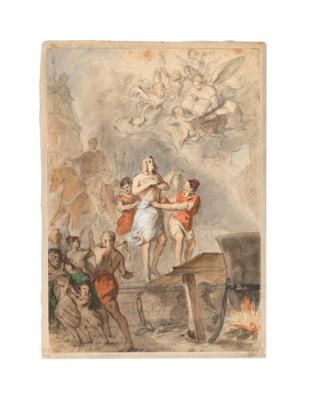Josef Danhauser

(Vienna 1805-1845)
The martyrdom of Saint John, study for the altar painting in the cathedral of Erlau, signed, dated Danhauser 1833, pencil, watercolour, heightened with white, on paper, 35,2 x 24,8 cm, the old mount attached to support, browned, somewhat stained, mounted, unframed, (Sch)
Literature:
Veronika Birke (Ed.), Josef Danhauser (1805-1845) - Gemälde und Zeichnungen, Vienna 1983, Cat. 22, fig. 6, p. 34.
Provenance:
Auction sale Gilhofer & Ranschburg, 4th April 1935, lot 720 (collection Rich. Breitenfeld and Aug. Heymann);
art auction sale, Karl & Faber, Munich, 6th June 1968, lot 409;
598. Kunstauktion Dorotheum, Vienna, 28th November 1972, lot 184 (fig.);
Private collection, Germany.
In 1833, Josef Danhauser was commissioned by Archbishop Ladislaus Pyrker to execute a painting for the high altar of the newly built cathedral church in Eger, a project that counted among the most important ones in the young artist's career. The altarpiece is still in situ today and represents "John ante portam latinam". It shows the last steps of John with his bound feet before his martyrdom. The impressive scene was carefully prepared by Danhauser in a series of drawings, in which he gradually developed the composition.
The present design which was often mentioned in the scientific literature and which was considered lost (cf. Birke 1983, p. 33, n. 4), is dated 1833 and shows a detailed and pictorially executed composition of the painting. John has his arms crossed in front of his chest;
he is rendered centrally along the middle axis of the picture. The arrangement of the surrounding figures was changed. As opposed to an earlier sketch which is kept in the Landesmuseum in Linz (cf. Birke 1983, p. 33, n. 4) the present figure arrangement is inscribed in a pyramid-like composition. A single sketch with the drapery of the loincloth and the position of John’s legs as well as two other preliminary studies of two minions are kept in the Kupferstichkabinett of the Academy of Fine Arts in Vienna (Birke 1983, cat. 22.1 and cats. 22.2., 22.3.) The sketches attest to the careful and detailed preparation of the later composition. The present, rediscovered sketch is stylistically still strongly indebted to the academic tradition, the detailed hints in watercolour regarding the colours of the painting, albeit still restrained, point to Danhauser's drawing style of the coming years.
Expert: Mag. Astrid-Christina Schierz
 Mag. Astrid-Christina Schierz
Mag. Astrid-Christina Schierz
+43-1-515 60-546
astrid.schierz@dorotheum.at
28.09.2022 - 15:27
- Dosažená cena: **
-
EUR 2.176,-
- Odhadní cena:
-
EUR 1.200,- do EUR 1.600,-
- Vyvolávací cena:
-
EUR 800,-
Josef Danhauser
(Vienna 1805-1845)
The martyrdom of Saint John, study for the altar painting in the cathedral of Erlau, signed, dated Danhauser 1833, pencil, watercolour, heightened with white, on paper, 35,2 x 24,8 cm, the old mount attached to support, browned, somewhat stained, mounted, unframed, (Sch)
Literature:
Veronika Birke (Ed.), Josef Danhauser (1805-1845) - Gemälde und Zeichnungen, Vienna 1983, Cat. 22, fig. 6, p. 34.
Provenance:
Auction sale Gilhofer & Ranschburg, 4th April 1935, lot 720 (collection Rich. Breitenfeld and Aug. Heymann);
art auction sale, Karl & Faber, Munich, 6th June 1968, lot 409;
598. Kunstauktion Dorotheum, Vienna, 28th November 1972, lot 184 (fig.);
Private collection, Germany.
In 1833, Josef Danhauser was commissioned by Archbishop Ladislaus Pyrker to execute a painting for the high altar of the newly built cathedral church in Eger, a project that counted among the most important ones in the young artist's career. The altarpiece is still in situ today and represents "John ante portam latinam". It shows the last steps of John with his bound feet before his martyrdom. The impressive scene was carefully prepared by Danhauser in a series of drawings, in which he gradually developed the composition.
The present design which was often mentioned in the scientific literature and which was considered lost (cf. Birke 1983, p. 33, n. 4), is dated 1833 and shows a detailed and pictorially executed composition of the painting. John has his arms crossed in front of his chest;
he is rendered centrally along the middle axis of the picture. The arrangement of the surrounding figures was changed. As opposed to an earlier sketch which is kept in the Landesmuseum in Linz (cf. Birke 1983, p. 33, n. 4) the present figure arrangement is inscribed in a pyramid-like composition. A single sketch with the drapery of the loincloth and the position of John’s legs as well as two other preliminary studies of two minions are kept in the Kupferstichkabinett of the Academy of Fine Arts in Vienna (Birke 1983, cat. 22.1 and cats. 22.2., 22.3.) The sketches attest to the careful and detailed preparation of the later composition. The present, rediscovered sketch is stylistically still strongly indebted to the academic tradition, the detailed hints in watercolour regarding the colours of the painting, albeit still restrained, point to Danhauser's drawing style of the coming years.
Expert: Mag. Astrid-Christina Schierz
 Mag. Astrid-Christina Schierz
Mag. Astrid-Christina Schierz
+43-1-515 60-546
astrid.schierz@dorotheum.at
|
Horká linka kupujících
Po-Pá: 10.00 - 17.00
kundendienst@dorotheum.at +43 1 515 60 200 |
| Aukce: | Mistrovské kresby, Tisky do roku 1900 |
| Typ aukce: | Online aukce |
| Datum: | 28.09.2022 - 15:27 |
| Místo konání aukce: | Wien | Palais Dorotheum |
| Prohlídka: | 23.09. - 28.09.2022 |
** Kupní cena vč. poplatku kupujícího a DPH
Není již možné podávat příkazy ke koupi přes internet. Aukce se právě připravuje resp. byla již uskutečněna.
Všechny objekty umělce
